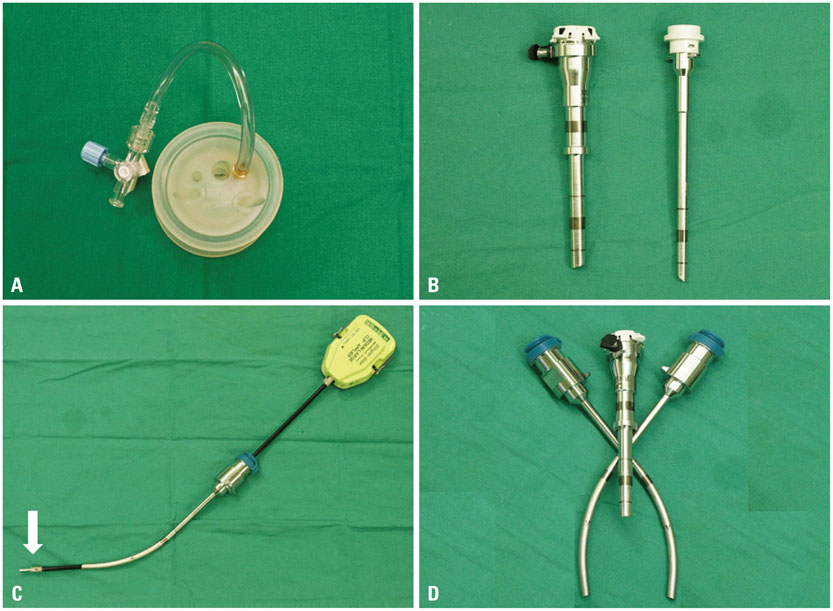The First Experiences of Robotic Single-Site Cholecystectomy in Asia: A Potential Way to Expand Minimally-Invasive Single-Site Surgery?
- Affiliations
-
- 1Department of Surgery, Yonsei University College of Medicine, Pancreaticobiliary Cancer Clinic, Institute of Gastroenterology, Severance Hospital, Seoul, Korea. cmkang@yuhs.ac
- KMID: 2352806
- DOI: http://doi.org/10.3349/ymj.2015.56.1.189
Abstract
- PURPOSE
Herein, we firstly present the robotic single-site cholecystectomy (RSSC) as performed in Asia and evaluate whether it could overcome the limitations of conventional laparoscopic single-site cholecystectomy.
MATERIALS AND METHODS
From October 2013 to November 2013, RSSC for benign gallbladder (GB) disease was firstly performed consecutively in five patients. We evaluated these early experiences of RSSC and compared factors including clinicopathologic factors and operative outcomes with our initial cases of single-fulcrum laparoscopic cholecystectomy (SFLC).
RESULTS
Four female patients and one male patient underwent RSSC. Neither open conversion nor bile duct injury or bile spillage was noted during surgery. In comparisons with SFLC, patient-related factors in terms of age, sex, Body Mass Index, diagnosis, and American Society of Anesthesiologist score showed no significant differences between two groups. There were no significant differences in the operative outcomes regarding intraoperative blood loss, bile spillage during operation, postoperative pain scale values, postoperative complications, and hospital stay between the two groups (p<0.05). Actual dissection time (p=0.003) and total operation time (p=0.001) were significantly longer in RSSC than in SFLC. There were no drain insertion or open conversion cases in either group.
CONCLUSION
RSSC provides a comfortable environment and improved ergonomics to laparoscopic single-site cholecystectomy; however, this technique needs to be modified to allow for more effective intracorporeal movement. As experience and technical innovations continue, RSSC will soon be alternative procedure for well-selected benign GB disease.
Keyword
MeSH Terms
Figure
Cited by 4 articles
-
Comparison of outcomes of single incision robotic cholecystectomy and single incision laparoscopic cholecystectomy
Sun Min Lee, Jin Hong Lim
Ann Hepatobiliary Pancreat Surg. 2021;25(1):78-83. doi: 10.14701/ahbps.2021.25.1.78.Technical feasibility of da Vinci SP single-port robotic cholecystectomy: a case report
Charles Jimenez Cruz, Hye Yeon Yang, Incheon Kang, Chang Moo Kang, Woo Jung Lee
Ann Surg Treat Res. 2019;97(4):217-221. doi: 10.4174/astr.2019.97.4.217.Cholecystectomy for Prevention of Recurrence after Endoscopic Clearance of Bile Duct Stones in Korea
Myung Eun Song, Moon Jae Chung, Dong-Jun Lee, Tak Geun Oh, Jeong Youp Park, Seungmin Bang, Seung Woo Park, Si Young Song, Jae Bock Chung
Yonsei Med J. 2016;57(1):132-137. doi: 10.3349/ymj.2016.57.1.132.ArtiSential laparoscopic cholecystectomy: a comparative analysis with robotic single-port cholecystectomy
Seoung Yoon Rho, Munseok Choi, Sung Hyun Kim, Seung Soo Hong, Brian Kim Poh Goh, Yuichi Nagakawa, Minoru Tanabe, Daisuke Asano, Chang Moo Kang
Ann Surg Treat Res. 2024;107(6):336-345. doi: 10.4174/astr.2024.107.6.336.
Reference
-
1. Zucker KA, Bailey RW, Gadacz TR, Imbembo AL. Laparoscopic guided cholecystectomy. Am J Surg. 1991; 161:36–42.
Article2. Ouchi K, Mikuni J, Kakugawa Y. Organizing Committee, The 30th Annual Congress of the Japanese Society of Biliary Surgery. Laparoscopic cholecystectomy for gallbladder carcinoma: results of a Japanese survey of 498 patients. J Hepatobiliary Pancreat Surg. 2002; 9:256–260.
Article3. Kang CM, Choi GH, Park SH, Kim KS, Choi JS, Lee WJ, et al. Laparoscopic cholecystectomy only could be an appropriate treatment for selected clinical R0 gallbladder carcinoma. Surg Endosc. 2007; 21:1582–1587.
Article4. Bucher P, Pugin F, Buchs N, Ostermann S, Charara F, Morel P. Single port access laparoscopic cholecystectomy (with video). World J Surg. 2009; 33:1015–1019.
Article5. Rao PP, Bhagwat SM, Rane A, Rao PP. The feasibility of single port laparoscopic cholecystectomy: a pilot study of 20 cases. HPB (Oxford). 2008; 10:336–340.
Article6. Chamberlain RS, Sakpal SV. A comprehensive review of single-incision laparoscopic surgery (SILS) and natural orifice transluminal endoscopic surgery (NOTES) techniques for cholecystectomy. J Gastrointest Surg. 2009; 13:1733–1740.
Article7. Kroh M, El-Hayek K, Rosenblatt S, Chand B, Escobar P, Kaouk J, et al. First human surgery with a novel single-port robotic system: cholecystectomy using the da Vinci Single-Site platform. Surg Endosc. 2011; 25:3566–3573.
Article8. Wren SM, Curet MJ. Single-port robotic cholecystectomy: results from a first human use clinical study of the new da Vinci single-site surgical platform. Arch Surg. 2011; 146:1122–1127.9. Spinoglio G, Priora F, Bianchi PP, Lucido FS, Licciardello A, Maglione V, et al. Real-time near-infrared (NIR) fluorescent cholangiography in single-site robotic cholecystectomy (SSRC): a single-institutional prospective study. Surg Endosc. 2013; 27:2156–2162.
Article10. Choi SH, Hwang HK, Kang CM, Lee WJ. Single-fulcrum laparoscopic cholecystectomy: a single-incision and multi-port technique. ANZ J Surg. 2012; 82:529–534.
Article11. Hwang HK, Choi SH, Kang CM, Lee WJ. Single-fulcrum laparoscopic cholecystectomy in uncomplicated gallbladder diseases: a retrospective comparative analysis with conventional laparoscopic cholecystectomy. Yonsei Med J. 2013; 54:1471–1477.
Article12. Vidovszky TJ, Smith W, Ghosh J, Ali MR. Robotic cholecystectomy: learning curve, advantages, and limitations. J Surg Res. 2006; 136:172–178.
Article13. Kravetz AJ, Iddings D, Basson MD, Kia MA. The learning curve with single-port cholecystectomy. JSLS. 2009; 13:332–336.14. Solomon D, Bell RL, Duffy AJ, Roberts KE. Single-port cholecystectomy: small scar, short learning curve. Surg Endosc. 2010; 24:2954–2957.
Article15. Gumbs AA, Milone L, Sinha P, Bessler M. Totally transumbilical laparoscopic cholecystectomy. J Gastrointest Surg. 2009; 13:533–534.
Article16. Spinoglio G, Lenti LM, Maglione V, Lucido FS, Priora F, Bianchi PP, et al. Single-site robotic cholecystectomy (SSRC) versus single-incision laparoscopic cholecystectomy (SILC): comparison of learning curves. First European experience. Surg Endosc. 2012; 26:1648–1655.
Article17. Chang L, Satava RM, Pellegrini CA, Sinanan MN. Robotic surgery: identifying the learning curve through objective measurement of skill. Surg Endosc. 2003; 17:1744–1748.
Article
- Full Text Links
- Actions
-
Cited
- CITED
-
- Close
- Share
- Similar articles
-
- Minimally Invasive Single-Site Cholecystectomy in Obese Patients: Laparoscopic vs. Robotic
- Comparison of Single-Incision Robotic Cholecystectomy, Single-Incision Laparoscopic Cholecystectomy and 3-Port Laparoscopic Cholecystectomy -Postoperative Pain, Cosmetic Outcome and Surgeon's Workload
- Minimally Invasive Single-Site Cholecystectomy in Obese Patients: Laparoscopic vs. Robotic
- Single-incision Robotic Cholecystectomy: Initial Experience and Results
- Single-incision Robotic Cholecystectomy: Initial Experience and Results




